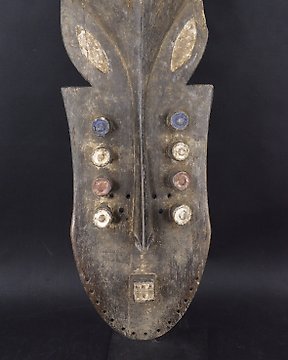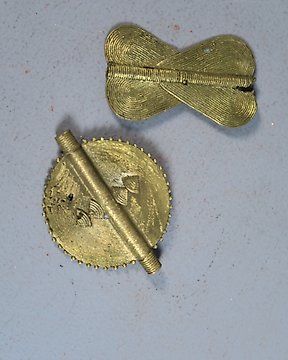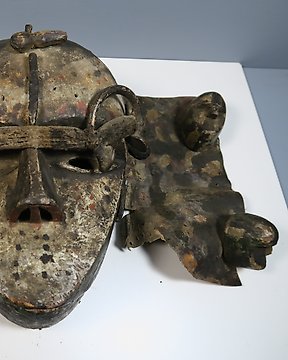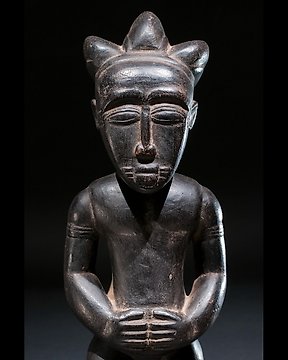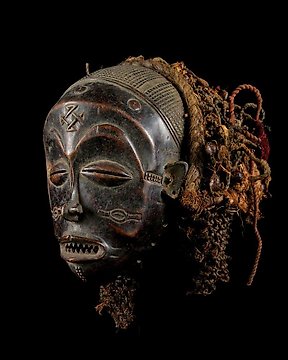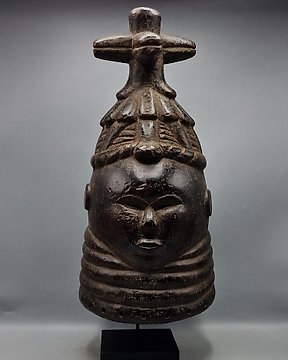große weibliche Ahnenstatue - Bété - Elfenbeinküste
Nr. 83430817

Yaure - Elfenbeinküste
Nr. 83430817

Yaure - Elfenbeinküste
A Yaure mask, Central Ivory Coast, collected in the village N'Govia, of oval shape, a delicate mouth, long thin nose, half opened eyes, crescent eyebrows, delicate hairdo draped on the forehead, a bird is standing on the head, who’s neck is attached with a rope to the head. The harmonious a-symmetry of this item evoke feelings of tranquility and balance, thus contributing to its overall value. The prominent forehead and contemplative gaze reflect the Baule aesthetic's emphasis on intellect and reverence, where its nuanced individuality, highly refined details, powerful presence. Some traces of use, thick ritual patina, traces of white paint.
“To articulate historians, the most consistent features of Baule art is a kind of peaceful containment. Faces tend to have downcast eyes and figures most often hold their ams against the body. […] Among their abundant art forms, the Baule people continue to place the greatest value on masks and figure sculptures, which remain the only sculptural art still widely used in Baule villages. While there is a difference between the Baule view of their objects and that of Western connoisseurs, there are points of agreement. Aesthetic appreciation is one: Baule artist, and individual owners of objects, certainly sometimes enjoy the beauty of these objects and the skill it took coproduce them. […]
Ornaments above the face are chosen for their beauty and have no iconographic significance” p.141
Lit: Baule: African Art, Western Eyes. Susan M.Vogel 1997
"Portrait masks embody the core Baule sculptural style that is echoed in figural sculpture and decorative arts. They also have provided Baule sculptors with their prime opportunity for artistic invention, and the corpus demonstrates enormous formal diversity. This diversity is often apparent in imaginative decorative passages extending above the face […] Such masks appeared as the final sequence of an operatic public entertainment known as Mblo. Mblo performances consist of a succession of dances that escalate in complexity and importance, culminating ultimately in tributes to the community's most distinguished member. Individuals honored in this way are depicted by a mask that is conceived of as their artistic double or namesake."
Lit: The Metropolitan Museum of Art. The Metropolitan Museum Bulletin: Recent Acquisitions, 2004-2005 (Fall 2005), p. 47.
"The Baule are originally part of a breakaway group of the Akan people from Ghana. In the 17th century, Queen Abla Pokou led a group on an exodus away from the main Ashanti Confederacy after a war broke out due to disagreements among the factions. Pokou realized that she and her followers may be in harms way, so she took her people and headed westward. Legend says the group came upon the Comoé River, with its dangerous waters and needed a way to safely cross. With the enemy gaining on them, Queen Pokou asked a diviner for advice. The diviner, after much thought, told her the gods required a sacrifice. Everyone began throwing their most prized possessions into the river; gold, ivory, cattle, everything they owned, hoping to appease the gods. The diviner shook his head and said that our sons are our most prized possessions. Pokou, knowing that her duty as queen was more important than that of a mother, decided then to sacrifice her only son, throwing him into the water and calling out “Ba ouli”, translated to “the child is dead”, giving them the name Baule. After the sacrifice was made, hippopotamuses came up from the river and formed a bridge allowing the queen and her people to cross."
"Differing from most cultures, the Baule are a matriarchal society. Not only are genetic lineages traced by the mother’s blood line, but they refrain from participating in secret societies and initiations that usually forbid women. They believe women’s rights are sacred and are for the most part, given the same opportunities as men. They do however, have some objects such as special men’s masks or anthropomorphic monkeys that women are forbidden to see due to fear of harm or death."
Information found on Discover African Art.
Das könnte Ihnen auch gefallen
- 16+
Dieses Objekt wurde vorgestellt in:
So kaufen Sie auf Catawiki
1. Etwas Besonderes entdecken
2. Höchstgebot abgeben
3. Sichere Zahlung durchführen

